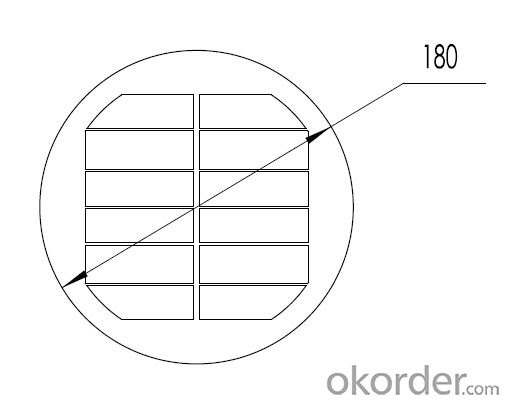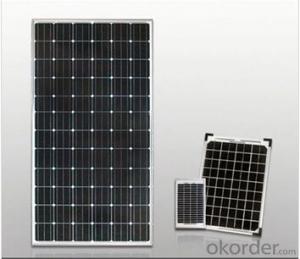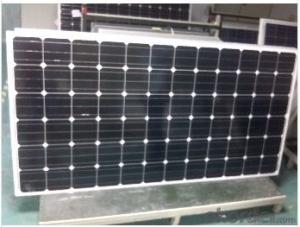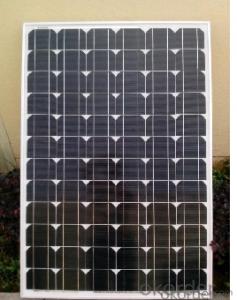Goats Solar Panels Round Solar Panel
OKorder Service Pledge
Quality Product, Order Online Tracking, Timely Delivery
OKorder Financial Service
Credit Rating, Credit Services, Credit Purchasing
You Might Also Like
Round shape can meet unique demand of customers and with high effcient solar cells and double high transmissivity low-iron toughened glass ,the panels get esthetic appearance, and stand high wind-pressure and snow load.
It can be installed everywhere needed.
features and benefits:
High-efficient solar cells
High transmissivity low-iron toughened glass
Anodized aluminum frame
25 year poweroutput warranty
- Q: Hi! I bought a Coleman 2 vdc cooler that pulls 9 amps. What size solar panel and amp-hour battery do I need? I only open it 3 times a day. It will hold about 3 gals of milk.
- If it pulls 9 amps continuously, that's 08 watts/hour or about 2.5 kwh/day. If it only pulls half that (does it cycle?) it's about .2 kwh/day. You only want to drain a lead-acid battery 50% or so, so you'll want a 5 or 2.5 kwh battery pack. A typical setup for the 5 kwh would be two L-6 batteries in series, and for the 2.5 kwh you could use 2 T-05 batteries in series. This does not account for days of cloud. If you regularly have cloudy days, size the battery pack for two or three days of use with no input (2-3 x the sizes given above). To charge them, you typically want panels that will charge your battery at least 5% of its capacity per hour (C/20). For 2 volt nominal panels that's 0 amps for the T-05 or 20 amps for the L-6 batteries. It's good to have more than that for battery life (it cuts down on what's called stratification), so you'll want probably 50-200 watts of panels for the T-05 and 300-400 for the L-6. You'll also need a charge controller. Peltier coolers are very inefficient. You'll save money by using a regular mini-fridge and an inverter. Most mini-fridges only draw 50 watts or so, so you're talking 600 watt-hours for a 50% duty cycle. This means two T-05 batteries will give you two days of use and you'll only need 20-50 watts of panel. DK
- Q: I want to get solar panels but not spend 20,000!! I found out that you can get a panel to run only your AC unit, I also found something that will run my pool pump! Anyone own either of these? How did you do? Where did you go? How much was it, and was it hard to install?
- Most major cities have construction signs and other public things powered by solar panels. We have parking meter stands, USGS meters, street lights, etc. when these lose efficiency, they need to be replaced. They still work at about 60 percent efficiency. Learn who services these items and ask how to get them at a reduced rate or even for free. Be personable and nice and go to the source physically, not via e-mail. You can get a solar panel to run just about anything
- Q: Can solar panels be installed on bus stops or shelters?
- Yes, solar panels can be installed on bus stops or shelters.
- Q: Can solar panels be installed on a church or place of worship?
- Yes, solar panels can be installed on a church or place of worship. In fact, many religious institutions have embraced solar energy as a sustainable and environmentally-friendly solution for their energy needs. Installing solar panels on a church can help reduce energy costs, lower carbon footprint, and demonstrate a commitment to stewardship of the earth's resources. Additionally, solar panels on a place of worship can serve as a symbol of the institution's values and inspire the community to adopt clean energy practices.
- Q: Do solar panels require a battery?
- No, solar panels do not require a battery.
- Q: For those solar panels that you install on your rooftops, do they generate electricity when it's cloudy? And if yes, how much electricity does it generate compared to sunny days? For example...like only 25% electricity generated compared to sunny days?
- From my understanding they generate electricity when the suns out and when its out and there aren't too many clouds around covering up. They store some electricity for the winter and cloudier times but I'm not really an expert!
- Q: I have a solar panel that puts out 00v, .5 amps in full sun. Before I thought it would charge a 2v battery without a solar charger but then I talked to someone and they said that it was wasting a lot of power and could potentially hurt the battery. A second part to this question is what happens if I put it on a 72v battery without a controller. Thanks!
- The solar panel is capable of /2 Amp output. If you hook it to a 2V battery directly and the battery is discharged it will want more than /2 Amp and pull the voltage down until the battery is charged to a certain level. Eventually the battery will try to charge up to 00V which will definitely damage the battery. If you use a regulator circuit running off the solar panel that outputs 2V then you will have a constant voltage circuit which will still be limited to /2A or whatever the regulator is capable of outputting. Of course you can't just go out and connect 00V to any voltage regulator it has to be capable of running from 00V and dropping the voltage to 2V like the original charger that comes with the battery. The same explanation applies to a 72V battery. You have to limit the output voltage to 72V or risk overcharging the battery.
- Q: Can solar panels be installed on a school or educational institution?
- Yes, solar panels can be installed on a school or educational institution. In fact, many schools and educational institutions are increasingly adopting solar energy as a sustainable and cost-effective solution for their power needs. Solar panels can be installed on rooftops, parking lots, or open areas to generate clean electricity, reduce carbon emissions, and provide educational opportunities for students to learn about renewable energy.
- Q: how to market solar energy products?
- You'd better build some sample project. For e.g, if you mean solar water heater, install one pc on your roof, and make it generate hot water, and tell people about it.
- Q: I'm very interested in how solar panels work. I understand the bigger picture of how it can be used for solar heating or as a generator, but I'm lost at the smaller details. Things like: - Could my computer work on solar? It has a 900 watt power supply (this is excluding monitor/speakers) - if a panel is for example, a 60 watt panel, does this mean it will pump 60 watts a second into a battery? - Does solar heating make the water electrified?
- There's okorder /
Send your message to us
Goats Solar Panels Round Solar Panel
OKorder Service Pledge
Quality Product, Order Online Tracking, Timely Delivery
OKorder Financial Service
Credit Rating, Credit Services, Credit Purchasing
Similar products
Hot products
Hot Searches
Related keywords





















